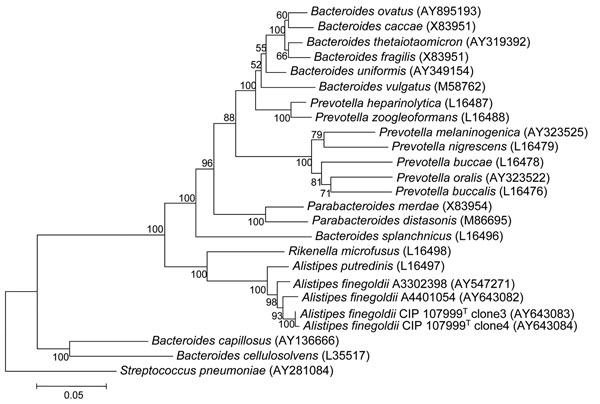Volume 13, Number 8—August 2007
Letter
Alistipes finegoldii in Blood Cultures from Colon Cancer Patients
Figure

Figure. Phylogenetic tree inferred from comparison of the 16S rRNA gene sequences of genera Bacteroides, Parabacteroidetes, Prevotella, and Alistipes. Nucleotide accession numbers for the sequences used to construct this dendrogram are given in parentheses. The tree was constructed with MEGA version 2.1 (www.megasoftware.net). Distance matrices were determined following the assumptions described by Kimura (3) and were used to elaborate the dendrogram with the neighbor-joining method. Bar, 0.05-nt change per nucleotide position. Streptococcus pneumoniae was used as the outgroup.
References
- Rautio M, Lonnroth M, Saxen H, Nikku R, Väisanen ML, Finegold SM, Characteristics of an unusual anaerobic pigmented gram-negative rod isolated from normal and inflamed appendices. Clin Infect Dis. 1997;25(Suppl 2):S107–10. DOIPubMedGoogle Scholar
- Rautio M, Saxen H, Siitonen A, Nikku R, Jousimies-Somer H. Bacteriology of histopathologically defined appendicitis in children. Pediatr Infect Dis J. 2000;19:1078–83. DOIPubMedGoogle Scholar
- Kimura M. A simple method for estimating evolutionary rates of base substitutions through comparative studies of nucleotide sequences. J Mol Evol. 1980;16:111–20. DOIPubMedGoogle Scholar
- Rautio M, Eerola E, Väisänen-Tunkelrott ML, Molitoris D, Lawson P, Collins MD, Reclassification of Bacteroides putredinis (Weinberg et al., 1937) in a new genus Alistipes gen. nov., as Alistipes putredinis comb.nov., and description of Alistipes finegoldii sp. nov., from human sources. Syst Appl Microbiol. 2003;26:182–8. DOIPubMedGoogle Scholar
- Weisburg WG, Barns SM, Pelletier DA, Lane DJ. 16S ribosomal DNA amplification for phylogenetic study. J Bacteriol. 1991;173:697–703.PubMedGoogle Scholar
- Fenner L, Roux V, Mallet MN, Raoult D. Bacteroides massiliensis sp. nov., isolated from blood culture of a newborn. Int J Syst Evol Microbiol. 2005;55:1335–7. DOIPubMedGoogle Scholar
- Rigottier-Gois L, Rochet V, Garrec N, Suau A, Doré J. Enumeration of Bacteroides species in human faeces by fluorescent in situ hybridisation combined with flow cytometry using 16S rRNA probes. Syst Appl Microbiol. 2003;26:110–8. DOIPubMedGoogle Scholar
- Brook I. Clinical review: bacteremia caused by anaerobic bacteria in children. Crit Care. 2002;6:205–11. DOIPubMedGoogle Scholar
- Wareham DW, Wilks M, Ahmed D, Brazier JS, Millar M. Anaerobic sepsis due to multidrug-resistant Bacteroides fragilis: microbiological cure and clinical response with linezolid therapy. Clin Infect Dis. 2005;40:67–8. DOIPubMedGoogle Scholar
- Feuillet L, Carvajal J, Sudre I, Pelletier J, Thomassin JM, Drancourt M, First isolation of Bacteroides thetaiotaomicron from a patient with a cholesteatoma and experiencing meningitis. J Clin Microbiol. 2005;43:1467–9. DOIPubMedGoogle Scholar
Page created: June 30, 2010
Page updated: June 30, 2010
Page reviewed: June 30, 2010
The conclusions, findings, and opinions expressed by authors contributing to this journal do not necessarily reflect the official position of the U.S. Department of Health and Human Services, the Public Health Service, the Centers for Disease Control and Prevention, or the authors' affiliated institutions. Use of trade names is for identification only and does not imply endorsement by any of the groups named above.